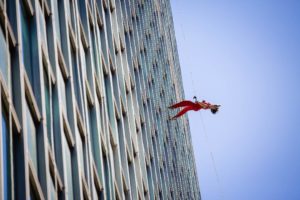Hybrid vision leads Orchid Ensemble, Aeriosa Dance, and Chimerik into Crossing Mountains & Seas
 Part meet-cute love story, part video game, part exploration of ancient Chinese mythology, Crossing Mountains & Seas has been, from its inception, an exercise in cultural and artistic hybridity. Encompassing the music of Vancouver’s Orchid Ensemble (whose leader and erhu player Lan Tung initiated the project), the vertical movement of Aeriosa Dance, and the computer-generated projections of the Chimerik new-media collective, it is also big, bold, and in many ways unprecedented.
Part meet-cute love story, part video game, part exploration of ancient Chinese mythology, Crossing Mountains & Seas has been, from its inception, an exercise in cultural and artistic hybridity. Encompassing the music of Vancouver’s Orchid Ensemble (whose leader and erhu player Lan Tung initiated the project), the vertical movement of Aeriosa Dance, and the computer-generated projections of the Chimerik new-media collective, it is also big, bold, and in many ways unprecedented.
Certainly, it’s hard to think of any artistic undertaking—in North America, at least—that has taken as its starting point Shan Hai Jing, a more than 2,000-year-old collection of legends, fables, and battle stories that Aeriosa founder and Crossing Mountains & Seas choreographer Julia Taffe compares to a cross between the Bible and Aesop’s Fables.
Even after premiering the work in Nanaimo last week, as part of Crimson Coast Dance’s InFrinGinG Dance Festival, Taffe is still coming to terms with the size and the scope of Crossing Mountains & Seas’ source text. For one thing, there’s the difficulty of reading Shan Hai Jing in English translation, which removes the pictorial aspect of Chinese calligraphy from the original. Then there’s the epic’s vast and fantastical cast of characters, a bewildering menagerie of part-human, part-reptile, part-bird, part-fish, and part-mammal creatures.
Shan Hai Jing, Taffe explains in a telephone interview from her Ucluelet home, is “a really ancient book that has been reimagined through history because of the loss of the original text, and because of the nature of the Chinese language, with its different representations of meaning.…It’s also very much a list of things, and so in that way it’s a very long read! But it is something that permeates deeply into Chinese culture, and has for such a long time. And the thing that was so interesting in that, for me, was the hybridity, and how that hybridity was really accepted as normal. So for all of us it felt very advanced compared to today, where we think we’re so modern and yet we have to label and compartmentalize and identify everything, and everything is ‘other’.”
Crossing Mountains & Seas illustrates that modern tendency through its love-story component, involving two video-game obsessives—one a young white woman, the other a young Asian man—who have to confront their own prejudices and social stereotypes before realizing that they might enjoy more than just an online friendship. Mostly, though, they communicate by texting—and through their role-playing adventures in the virtual reality of a new, Shan Hai Jing–themed video game.
Both are represented by media elements and by Aeriosa’s choreography, shared by Taffe and Chengxin Wei, which presents the real world through the crouched, phone-focused figures of Alex Tam and Thoenn Glover. It’s when the action shifts to fantasyland, with Cara Siu joining Tam and Glover to portray a variety of reptilian and birdlike avatars, that things take flight—quite literally. Aeriosa’s specialty is aerial dance, a fusion of gymnastics, silk work, and contemporary choreography in which the performers are suspended in harnesses above the stage, and this proves an effective way of conveying the truly uncanny nature of Shan Hai Jing’s alternative universe.
Perhaps counterintuitively, Taffe says that choreographing for a mythological turtle or a pair of one-winged birds is not as much of a stretch for her as depicting the earthbound cyberlovers.
“That’s actually somewhere I’m really comfortable,” she explains. “I have an interspecies family; I’ve always had animals and been interested in animals, and have also had experiences in nature with animals. Therefore I don’t see movement as only a human thing. I see different qualities of movement exhibited by different living creatures, and even by things like the wind and cycles of waves.…So, for me, it’s about identifying the qualities of movement that I’m interested in, and then expressing that through the dancers. Like, how does a fox move? How does a dragon move? Those are things that have always been, for me, at the root of my choreography.
“I have a harder time with human gestures,” she adds, laughing. “How do you represent drinking a cup of tea in choreography? That would be more of a challenge for me than saying ‘Please make a dolphin dive.’ ”
Taffe might also have a hard time letting Crossing Mountains & Seas go. The massive production will get only a single showing in Vancouver, with no immediate plans for further mountings. But the process of building it, the choreographer says, has been one of immense growth for all members of the team, and she hopes that the complex piece will be revisited soon.
“I’m really proud of it, I’m really excited, and I don’t feel like the work is finished,” she notes. “I feel like there’s more life in it, so I’ll be interested to see how it evolves.”
The Orchid Ensemble, Aeriosa Dance, and Chimerik present Crossing Mountains & Seas at the Vancouver Playhouse on Saturday (July 20).
by Alexander Varty on July 19th, 2019
